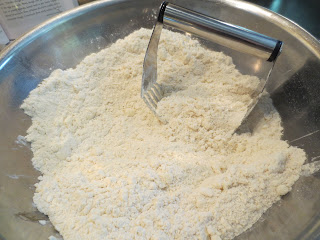Back in Oklahoma now, where it was 107 today and expected to go higher over the next several days. I decided to do something with some nectarines which I had in the refrigerator. I've never cooked with nectarines, but it seemed a summery thing to do. After perusing various recipes, I settled on "Nectarine Golden Cake" from Epicurious. For those of you unfamiliar with the site, it's a repository of recipes from Gourmet magazine (now defunct--I'm still angry about that) and Bon Appétit, as well as a few other places. The recipes are generally quite reliable, but there's also a reader review system which provides extra information. You can find the recipe at:
http://www.epicurious.com/recipes/food/views/Nectarine-Golden-Cake-354960
I followed the recipe exactly, with the exception of baking it an extra 10 minutes because I could find my 8" springform pan, but not my 9" inch springform pan, which the recipe calls for.
Nectarine Golden Cake
- 1 cup all-purpose flour
- 2 teaspoons baking powder
- Rounded 1/4 teaspoon salt
- 1 stick unsalted butter, softened
- 3/4 cup plus 1/2 tablespoon sugar, divided
- 2 large eggs
- 1 teaspoon pure vanilla extract
- 1/8 teaspoon pure almond extract
- 2 nectarines, pitted and cut into 1/2-inch-thick wedges
- 1/2 teaspoon grated nutmeg
- Equipment: a 9-inch springform pan
Preheat oven to 350°F with rack in middle. Lightly butter springform pan.
Whisk together flour, baking powder, and salt.
Beat butter and 3/4 cup sugar with an electric mixer until pale and fluffy. Add eggs 1 at a time, beating well after each addition, then beat in extracts. At low speed, mix in flour mixture until just combined.
Spread batter evenly in pan, then scatter nectarines over top. Stir together nutmeg and remaining 1/2 tablespoon sugar and sprinkle over top. Bake until cake is golden-brown and top is firm but tender when lightly touched (cake will rise over fruit), 45 to 50 minutes. Cool in pan 10 minutes. Remove side of pan and cool to warm.
So, the picture at the top of the page there are the lovely nectarines, sliced into 1/2" thick wedges. The cake batter was pretty standard. When I had made it up, I dumped it in the oiled springform pan.
I spread it around then began to lay the nectarines in.
The recipe says "scatter the nectarines," but I though what the heck, and arranged them in a pattern.
If you look closely, you can see the sugar and nutmeg sprinkled over the top. Did I mention that I used freshly grated nutmeg? It's really simple to grate and has a much brighter taste than the pre-ground stuff.
I baked it for 50 minutes, but the center was still not completely cooked, probably because I used an 8" rather than 9" pan. I baked it a further 10-12 minutes, until a knife inserted in the center came out clean. And here it is!
Now here's the funny, or at least ironic bit. I chose a nectarine dessert because it was a hot day. While I was baking it, our air-conditioning went out and the hot oven heated up the kitchen quite effectively. As I write, it's 86 degrees in the house and we're waiting for the repair guys to show up.
I can happily report, however, that this is one tasty cake, even when it is way too hot out! Yum. Maybe I'll give some to the repair guys.























